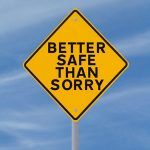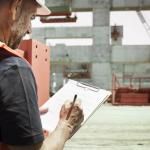
Prevention vs. Reaction: The Foundation of Safety Training
Prevention, as opposed to reaction, is the cornerstone of safety awareness & training. While it may seem like basics, we can’t underscore enough the need to be proactive when it comes to asfety and risk.
Let’s take a hypothetical example.
Danger May Be Approaching (or Maybe Not) – What Do You Do?
There is a hurricane moving northward in the Atlantic Ocean. It’s unclear at this time where it will make landfall, but let’s say you live in Nova Scotia which is within the target area. If the hurricane hits in the wrong place, at the wrong time, it can cause tremendous damage, flooding, maybe even loss of life. So, what do you do about it? Wait until the landfall area is clearly defined before you start preparing your home against the hurricane? Or do you get the shutters and wood up to protect your glass, put loose items away, and so on, even though the hurricane may end up in an entirely different area?
This is an example of a reactive versus a prevention-based safety program. The reaction, waiting for the hurricane, assumes that things happen, and there is really nothing to be done about it. The preventive approach, boarding up the home and protecting your family, demonstrates a proactive process. While the hurricane may shift paths, and your protection prove unnecessary, your proactive approach would have eliminated additional costs by reacting after the fact of the hurricane.
Translating Safety Proactiveness to the Workplace
 In an ideal workplace, the employees should feel confident that they will go home at night in the same condition as when they arrived at work. Implementation of various prevention methods, and preventive training, can help instill this confidence in your work force. But given the potential level of inertia, the thought of “that could never happen to me,” how does an employer engage his employees in a prevention-based safety training?
In an ideal workplace, the employees should feel confident that they will go home at night in the same condition as when they arrived at work. Implementation of various prevention methods, and preventive training, can help instill this confidence in your work force. But given the potential level of inertia, the thought of “that could never happen to me,” how does an employer engage his employees in a prevention-based safety training?
Safety is Priority #1
First and foremost is a clear demonstration that safety is a top priority in the organization. This can be accomplished by establishing a safety budget, showing visible and committed management support for safety, and having an understanding of what a preventive safety training program should accomplish. It will encompass effective practices and procedures, and well-written, comprehensive policies. Safety performance will be highly visible, and reporting on real time.
The safety iceberg (pictured above) tells us that for every visible accident, there are several, bigger, underlying conditions that are contributing to that accident. And for every risk that we may see, there are bigger risks lurking underneath.
Preventive Safety Programs
 It’s said that “a spoonful of sugar helps the medicine go down.” Safety training does not have to be a drudgery, putting everyone in the meeting to sleep. A preventive safety training program means working with employees, teaching them the tools and techniques to recognize these latent conditions, and to eliminate them before they end up contributing to a serious accident.
It’s said that “a spoonful of sugar helps the medicine go down.” Safety training does not have to be a drudgery, putting everyone in the meeting to sleep. A preventive safety training program means working with employees, teaching them the tools and techniques to recognize these latent conditions, and to eliminate them before they end up contributing to a serious accident.
While this can be accomplished with a formal safety program, with monthly meetings covering key topics, it is also just as effective to handle safety awareness on a daily basis, even for just a few minutes. This can be delivered through a morning tool-box meeting, contests and drawings, or just safety stories. Some teams or companies like to start every meeting with a safety topic. Whatever it takes to promote a culture of prevention and safety awareness.
A proactive, preventative approach to safety and accident reduction will bear benefits in the long and short term. As the culture becomes more and more ingrained in the organization, accident rates fall, employee ownership rises, and engagement increases. Employees begin looking out not just for themselves, but for others as well. The atmosphere of “them vs. us” – and the mistrust caused by a reactive environment – disappears – and is replaced by an environment of safety and security for every employee.
How ACT Can Help with Taking Proactive Stances to Safety
Advanced Consulting & Training are a leading safety training firm in Ontario. We’ve worked with countless organizations so that they can take control of their safety awareness and training programs, helping them become proactive in their approaches to safety.
Contact us today to find out how we can help you!


